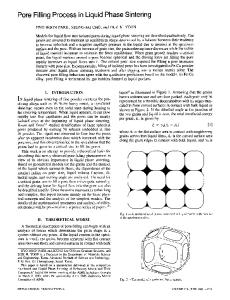Additive Sintering Process in Aluminum Nitride Ceramics
- PDF / 809,794 Bytes
- 5 Pages / 420.48 x 639 pts Page_size
- 38 Downloads / 310 Views
ADDITIVE SINTERING PROCESS IN ALUMINUM NITRIDE CERAMICS H.MAKIHARA AND N.KAMEHARA FUJITSU LABORATORIES LTD., Kanagawa, 243-01, Japan
10-1
Morinosato-Wakamiya,
Atsugi,
ABSTRACT Calcium compounds and yttrium compounds are frequently used as additives to densify AlN ceramics[l,2] . They react with oxygen impurities, such as A1203 in the raw AlN powder and in aluminate forms. A phase diagram is helpful in deciding the amount of additives to add, but the AlN sintering process doesn't come to equilibrium. We investigated the differences between sintering AlN with CaCO3 and with Y203. With CaCO3 added, the calcium-aluminate liquid phase evaporates from the sintered AlN body at high sintering temperatures. The AlN thermal conductivity doesn't increase above a sintering temperature of 1700*C because residual oxygen substitutes into the AlN grains. With Y203 added, AlN sinters below 1850 0 C, as predicted by a phase diagram. With a large amount of Y203 added, 5 wt%, thermal conductivity doesn't depend on residual oxygen. This is because yttrium doesn't evaporate from the sintered AlN body and residual oxygen substitutes into AlN grains at an early stage of the AlN sintering. INTRODUCTION Because aluminum nitride has a high thermal conductivity and a thermal expansion coefficient close to that of silicon, it is suitable for use as a packaging material for a silicon chip instead of alumina. Because AlN has strong covalent bonds and doesn't have a melting point[3], AlN is sintered using an additive which forms a liquid phase with A1203 impurities in the AlN powdwer. Alkaline earth compounds and rare earth compounds are well known AlN additives. But the liquid phase which forms with A1203 impurities decreases thermal conductivity(4]. Several sintering processes have been developed to obtain a high thermal conductivity. With CaC03 added, a high sintering gas pressure is used to remove the residual calcium-aluminate liquid phase(5]. With Y203 added, a carbon reduced atmosphere is used to remove yttrium-aluminate[6]. According to a phase diagram, an A1203 and CaO system has a lower melting point than an A1203 and Y203 system(7,8] . However, the differences between sintering AlN with these additives aren't well understood. In this study, we investigated various additive sintering processes in AlN.
Mat. Res. Soc. Symp. Proc. Vol. 249. @1992 Materials Research Society
438
EXPERIMENT We made two kinds of AlN samples using the green sheet method. The AlN powder contained 1 wt% of oxygen impurities. It is assumed that oxygen impurity forms A1203. One AlN powder sample was prepared with 3.57 wt% of CaCO3 added. We aimed at the lowest eutectic point, 1360*C* taken from a phase diagram of an A1203 and CaO system. The other was prepared with 0.5 to 5 wt% of Y203 added. The samples were placed in a boron nitride vessel to remove a carbon atmosphere from the heater in a furnace, and sintered for 9 hours at 1500 to 2000 0 C in a nitrogen atmosphere. After sintering, thermal conductivity was measured by the laser flash method. The residu
Data Loading...










